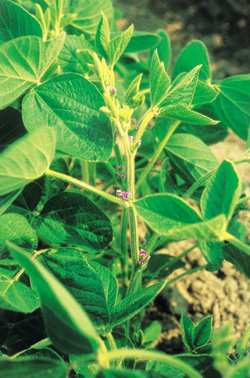
Features
Business & Policy
Consumer Issues
Building on a reputation
Grower stewardship plays an important role in quality and safety assurance of Canadian IP soybeans.
November 13, 2007 By Michelle McMullen*
 Canada is recognized worldwide as a producer and supplier of high quality specialty
Canada is recognized worldwide as a producer and supplier of high quality specialty
soybeans. Canada prides itself on meeting the needs, wants and concerns of international
customers through an integrated value chain approach which will guarantee that
customers receive the product they require.
Countless steps are taken to ensure safety of Canadian soybeans in partnership
with the Canadian Grain Commission (CGC). All players along the value chain
work to address food safety concerns of international markets. Food safety concerns,
including pesticide residues, are important issues that Canadians must address
when promoting IP soybeans to key markets.
On the international stage, three key elements stand out when it comes to Canada's
ability to provide quality and safety assurance on food grade soybeans: our
ability to deliver segregated and traceable soybeans to our customers through
the Canadian Identify Preserved Recognition System (CIPRS), available resources
to test for quality and safety of Canadian soybeans, and sophisticated production
practices.
CIPRS is an industry tool, operated by the CGC, which covers all aspects of
soybean production and processing from seed to export. It ensures that specialty
soybeans are kept separate from bulk-handle grains. CIPRS certification provides
international buyers with the assurance that they receive the product that meets
their specifications. Another benefit that the CGC provides to Canada's soybean
industry is its ability to assess quality attributes of Canadian soybeans –
grade, oil content and protein content – through an annual harvest quality
survey and experience in pesticide monitoring of cargo shipments of Canadian
soybeans.
Growers of IP soybeans are linked to quality and safety assurance starting
with their relationships with their local processor and their IP contracts:
specifying appropriate agronomic practices and pesticide usage. Highlighting
the thoroughness of IP contracts and the relationship growers have with their
local processor is an important feature for promotion to international markets.
Another key attribute is the mandatory compliance of growers to complete the
Ontario Grower Pesticide Education Program in order to buy or apply pesticides.
Taking this one day course, in addition to undergoing re-certification every
five years, ensures growers are up-to-date on changes such as handling and application
practices, alternative pest management practices, and new legislation and regulations.
This certification may seem like a nuisance to many growers across the province,
however, it speaks volumes to key markets such as Japan, since they know that
Canadian soybean growers have an informed and knowledgeable approach to pest
management.
Japan, currently Canada's largest importer of Canadian soybeans, with an approximate
value of $147 million in soybean purchases in 2004, continues to represent an
immense opportunity for Canadian agri-food products, including food grade specialty
soybeans.
A key characteristic defining this market is the growing concern of Japanese
consumers regarding food safety. This presents a challenge to Canada's soybean
industry to communicate and demonstrate its ability to supply a safe food product.
Japanese consumers reportedly perceive soybeans grown domestically to be safer
than imported soybeans. Hosting international buyers from markets such as Japan
can provide soy food companies first-hand knowledge regarding quality and safety.
They receive a 'seeing is believing' experience which, hopefully, will disseminate
the safety and quality features of Canadian soybeans to Japanese soy food consumers.
The recently implemented Japanese Food Sanitation Law is posing a challenge
for Canadian soybean exporters. The legislation, which is aimed at appeasing
the food safety fears of Japanese consumers, spells out maximum residue levels
(MRLs) for 333 pesticides used worldwide on soybeans, with only 41 of the pesticides
listed licensed in Canada for use on soybeans. Of these 41 pesticides, the Canadian
MRL is less stringent than the Japanese limit for only six of these items. The
other 35 pesticides registered in Canada for use on soybeans have equivalent
or more stringent MRLs than Japan.
With Canadian exporters facing demands for each shipment of soybeans to be
tested for pesticide residues to ensure compliance with the Japanese Food Sanitation
Law, the CGC investigated the risk of any cargo of Canadian soybeans exceeding
the stricter Japanese limits. The CGC concluded, based on recent cargo monitoring
results, Canada's thorough approach to licensing pesticides for use by growers
and developing standards for MRLs, and Canada's ability to segregate and trace
IP soybeans from bulk-handled grains, that the risk of Canadian soybeans to
Japan which exceed the specified limits is insignificant. The CGC will issue
a statement of assurance for Canadian soybeans referencing the Japanese Food
Sanitation Law to buyers requesting such documentation.
Canada is proud of its ability to be a dependable supplier of high quality
specialty soybeans. By continuing to draw upon the strengths of the Canadian
industry and its IP system, sophisticated farming practices and quality and
safety assurance programs, Canada can build upon its reputation as a producer
and supplier of safe, high quality specialty soybeans. -30-
*Michelle McMullen is industry opportunities co-ordinator with Ontario
Soybean Growers.